Cross-border shopping on the rise. But why?
Brands shipping their products overseas isn’t new, but it was not ideal for both the brands and the buyers. This is because overseas delivery tend to be costly, so buyers think the order’s total is less attractive, and brands cannot guarantee if the package is delivered to the buyer intact.
However, in recent years, despite all odds, cross-border shopping is becoming more and more popular. One explanation for this is the quarantine, it makes people do online shopping more, but bear in mind that large brands such as NEXT (UK), Asos (UK), Nordstrom (US), and global e-commerce sites like Amazon, AliExpress have always been popular and offer affordable overseas delivery, you could argue that cross-border shopping has always been popular, people just don’t want to spend too much on it, so the total value is low.
Recent findings show that pricing and availability of a specific brand or product are the top reasons why the trend is growing. People are very likely to make a purchase from overseas store if the price is attractive enough. A lot of the time, they shop because of the deals, such as discount or free shipping (and this is cross-border free-shipping by the way) and this plays a major role in their purchasing decisions. Other reasons they have to buy from foreign stores are because of the availability of the brands or that specific products, which is not unusual considering brands tend to have different product strategy in different markets.
Fast shipping is surprisingly also one of the top reason why people do overseas shopping, but in this case, it may means faster than they expected an international shipment can take.
With logistics companies working on better, faster delivery solutions for international trading after the Suez blockage, cross-border shopping can only do better from here.
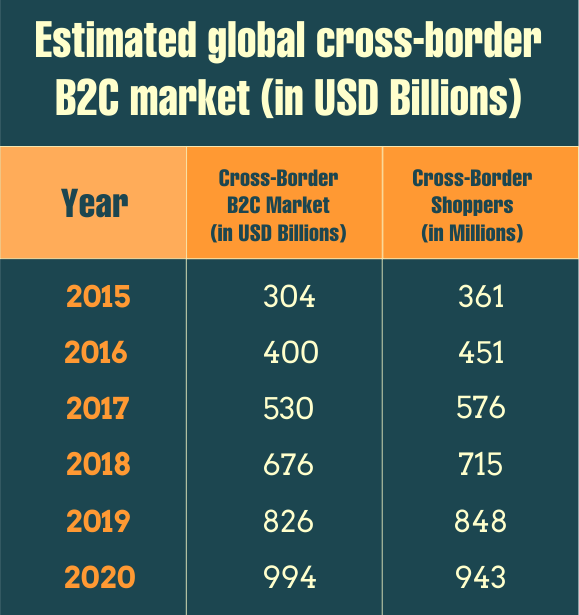
Cross-border shopping behaviour worldwide
-
By countries:
Though only ⅓ of shoppers in the US have done online shopping, the value of their transactions come up to US$76.9 billion, which is tremendously high in comparison to other countries and regions. The Canadian and the Mexican also buy online, and because of the geographic nature of these countries, they purchase mainly from US stores. Chinese products come second, though the value is considerably lower.
Europeans also shop overseas frequently, and it’s not just because of the free-trade agreement between their union. As a matter of fact, the value of goods the EU imported from China is just as big as the goods traded between European nations. Goods from the US account for a smaller amount, and noticeably high in the UK countries.
The Australian market is a big market for cross-border shopping, with couriers working on new, better logistics solutions to improve their services in the country. It is thought that they will trade mainly with the New Zealander but in reality, China, the US and the UK are the main markets to shop from.
If the Western and Western-like countries import Chinese products, who do the Chinese import from? It turns out, the Chinese love Japanese products, with Japan making up ¼ of China’s overseas order value. The Australian and the US come 2nd and 3rd respectively. So although the trade war was intense during Trump administration, trade between the US and China doesn’t stop, but going sideways.
Other countries in Asia also do hefty amount of cross-border shopping including Singapore (where cross-border shopping accounts for 55% of total e-commerce sales, so the Singaporean do more cross-border shopping than domestic), Malaysia (cross-border shopping takes up 45 percents of total e-commerce value), Vietnam (38%), Thailand (32%) Japan (25%), the Philippines (about 24%), Taiwan (20%).
South Korean also shop online, but because of the self-sufficient economy, the only reason they shop cross-border is because of pricing differences, hence the value of overseas shopping in South Korea only accounts for 5% of total e-commerce value.
-
By demographic
In terms of age, people under 35 are much more likely to shop from abroad, with 83% interested in buying from overseas. For those over 50 years of age, this figure is 67%, which is not bad.
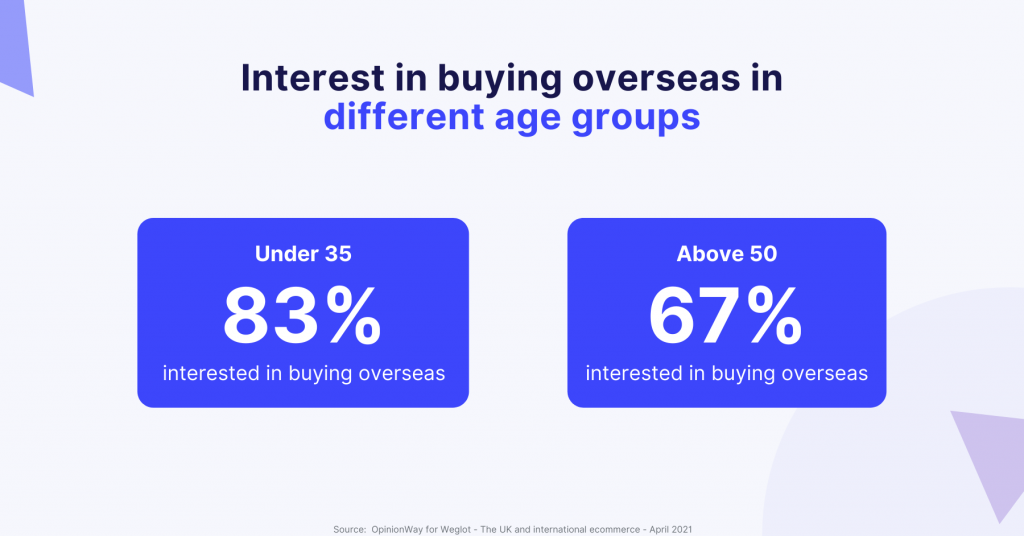
British people are very less likely (49%) to make purchases from sites which do not have English as a language option, which can be influential since English speakers tend to have huge buying power, such as the American, the British or the Singaporean.
For French speakers, they are also very likely to consult foreign businesses, but less likely to make the purchase.
-
By product
Clothing and fashion-related products are undeniably the biggest type of goods bought overseas, while books, office supplies such as stationeries, computer components and so on. Games is a surprising entry on the list but with the quarantine makes it reasonable. Electronics and beauty products follow at much lower quantity and value.
Products people from each country get from overseas also vary from nations.
Fashion-related products remain the top 1 most sought after product by the British and the French, but the second most popular type of goods the Brits bought overseas is leisure-related stuffs, such as books, games and so on. The third one is household items such as decorations. French people prefer to source their hi-tech items from outside their country, including IT components, HiFi and so on. Decorations, surprisingly, is also the third most popular type of goods for the French.
It’s not all similar for countries though, as US shoppers tend to buy computer software and hardware from outside their country, but also toys and beauty-related products.
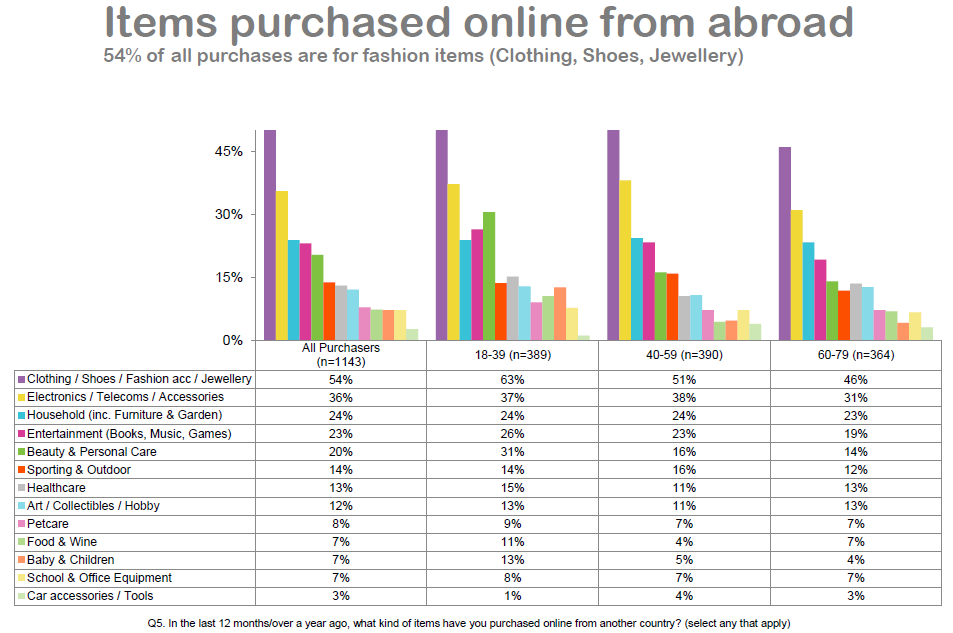
Why don’t they do cross-border shopping?
There are a lot of reasons to explain the latest surge in cross-border shopping, but there are also reasons why people don’t buy from overseas merchants, and it’s not just because they can’t try the clothes on to see how they look either. There’s more than that.
First of all, being fraud-conscious is the biggest reason why people don’t want to risk. People are very reluctant to even spend time on websites which don’t look legitimate, and this includes poor website design, unknown business details such as contact information, business location, product origin, shipping option and so on.
The second reason people hesitate making oversea purchases is customer services, especially return and exchange procedures. Normally, stores which only operate digitally tend to have different return and exchange policies, and while shipping to customer is one thing, people actually have no idea what to do and which service to use when they send the product back. That is not to mention that some items like electronics and DIY, decorations can be very difficult to package, let alone ship it back.
On top of that, shipping-related problems can potentially make or break a purchase. Nobody wants to place an order where the shipping fee is nearly or just as much as the cart’s value, so an unattractive shipping fee can make people seek alternative sites, offer or abandon the cart altogether. A shipment taking forever to come is also another big turn off. In today’s world, people want things to proceed as fast as possible. Overseas shipments tend to take time, and people are understanding of that, but if it takes too long to arrive, there’s a high chance customers don’t return. Of course, there are reasons for the delay that’s not your fault, but customers wouldn’t know or understand or sympathize with. There are times when the shipments get into customs, tax or handling trouble. It’s best to manage their expectations by updating them whenever necessary.
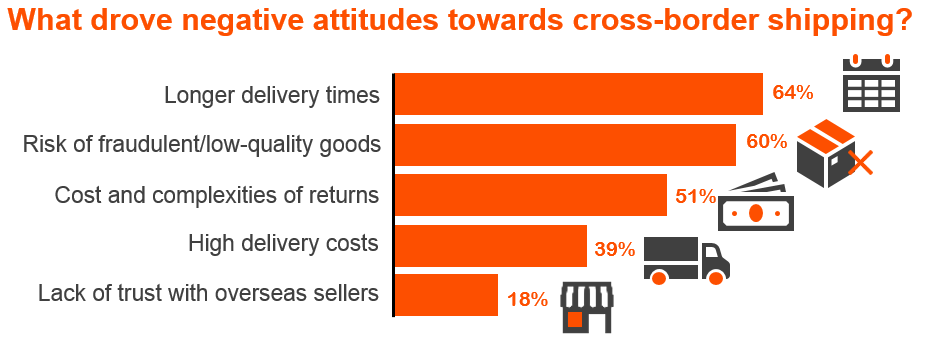
Boost overseas revenue with Group Order
Omega as a company is offering Group Order function on one of our apps - DingDoong. Group Order is a tool implemented on Shopify websites, allowing multiple people to join in on 1 cart. We understand that group ordering is not a new practice, especially when people order food. Apps like DoorDash, Uber, Grab already rolled this out on their respective apps, but there hasn’t been a similar function for Shopify stores. With Group Order on DingDoong, customers can shop in group much easier, and the type of product isn’t limited to food and drink, but can be anything!
We do believe that Group Order will be exceptionally useful for cross-border shopping. For shoppers, by getting multiple involved, it’s easier to meet promotional requirements. The more items in the cart, the higher the cart value, the more insignificant the shipping fee may seem, and it can also be split between people in the cart, making it even less impactful. For merchants, Group Order is not only a way to improve customer’s shopping experience, but by getting multiple involved, you’re both increasing the order’s value, making 1 shipment worthwhile, and having new people know about your store.
Now although all of the above can be applied to domestic and international customers, international customers take advantage of this a little more. They don't have the chance to visit the store in local countries, so sometimes more people are brought in to justify the shipping fee. Good deal is the biggest reason why they shop overseas, remember.
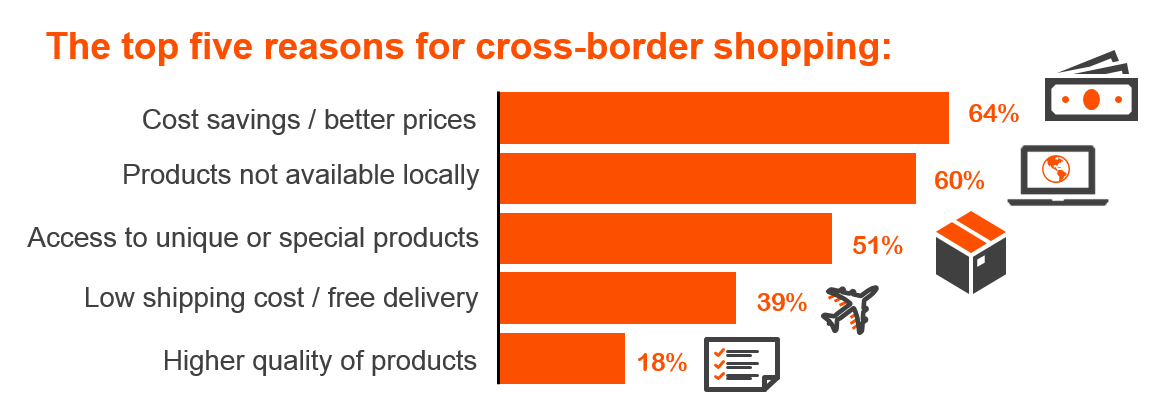
Group Order comes free with DingDoong: Delivery + Pickup app, and it’s super easy to set up and use. All you have to do is enable the function on your website, adjust the appearance according to your website’s design and you’re done. For customers, they can create a group order cart, and by doing so making them the cart’s owner. A link will be made to share with their friends so they can shop on their own device without having to log in. Once everyone finishes their shopping, the owner will finalize the cart, edit out any items they don’t want to pay, and pay for the entire cart. And that’s it.
With the cross-border trend going strong, such function will become a website’s feature, and others will try to adopt and catch up, and that’s when it becomes standard. That’s why we strongly recommend merchants to try and implement it as soon as possible!
You can try out the Group Order function on one of our demo store (password: 123).
If you want to check out our reference, or want to know more about cross-border shopping as a trend, check these out:
https://www.shopify.com/enterprise/global-ecommerce-statistics#4
https://www.thinkwithgoogle.com/feature/online-shopping-trends/markets/us?lang=en_US
https://weglot.com/blog/international-ecommerce-on-the-rise/
https://www.invespcro.com/blog/cross-border-shopping/
https://www.whistl.co.uk/research/international-buying-behaviours-trends-and-insights#form72
